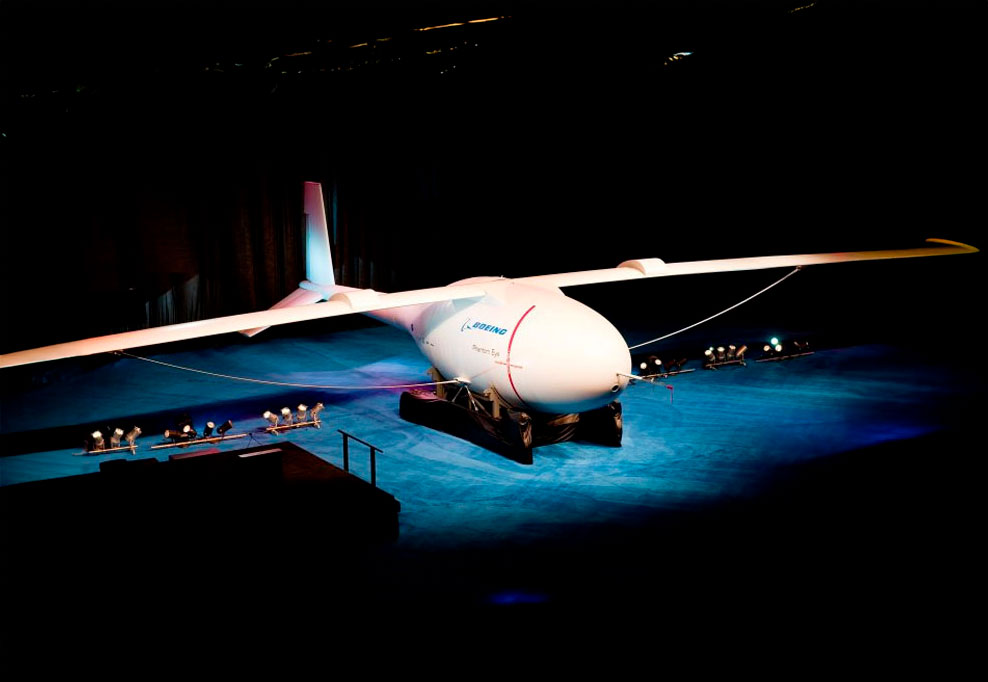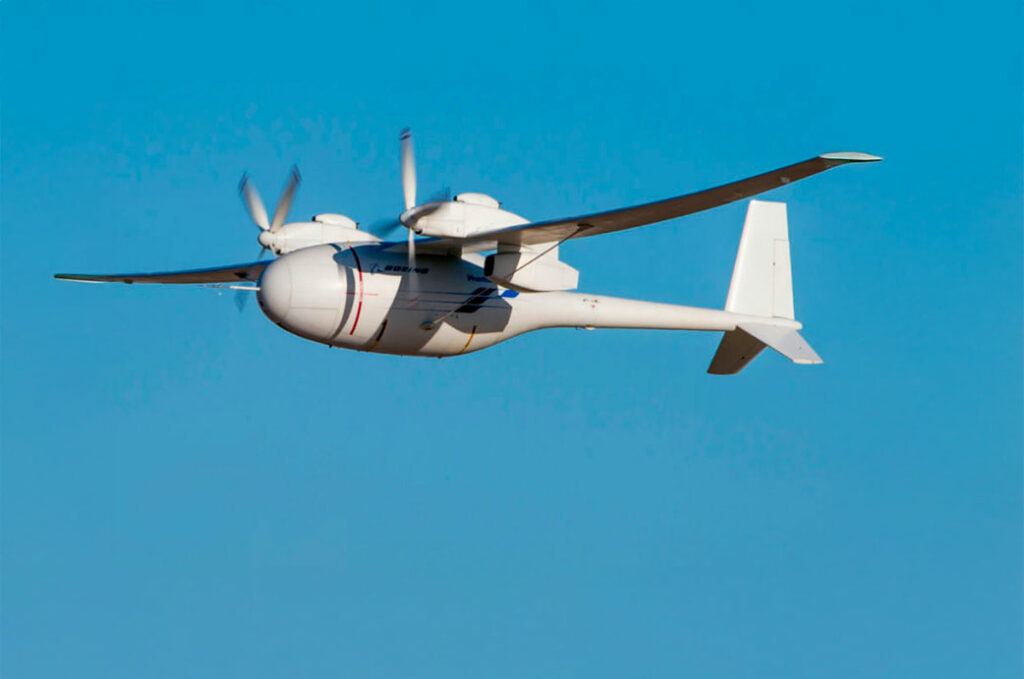The Boeing Phantom Eye HALE UAV is a hydrogen-powered, high-altitude, long-endurance surveillance aircraft designed for persistent ISR missions.
In brief
The Boeing Phantom Eye is a high-altitude, long-endurance (HALE) unmanned aerial vehicle (UAV) designed for extended Intelligence, Surveillance, and Reconnaissance (ISR) missions. Developed by Boeing, Phantom Eye runs on a hydrogen-powered propulsion system, allowing it to reach altitudes up to 65,000 feet (19,812 meters) and remain airborne for up to four days without refueling. With a wingspan of 150 feet (45.7 meters), it is optimized for lift and endurance, enabling it to cover vast areas over sustained periods. This UAV uses liquid hydrogen, producing only water as a byproduct, which makes it an environmentally friendly option for prolonged surveillance missions. Phantom Eye has a payload capacity of 450 pounds (204 kilograms), designed to carry advanced imaging and sensor equipment, enhancing its ISR capabilities. Its design represents Boeing’s commitment to innovative, sustainable aviation solutions, filling a niche for persistent surveillance at high altitudes.
The Boeing Phantom Eye HALE UAV
The Boeing Phantom Eye HALE UAV is an advanced unmanned aerial vehicle developed by Boeing to address the need for continuous, long-endurance ISR capabilities at high altitudes. Unlike conventional UAVs, Phantom Eye relies on a unique liquid hydrogen fuel system, providing an environmentally responsible option for military and civilian surveillance. Hydrogen-powered engines produce only water vapor, making the aircraft emission-free. This focus on sustainability, combined with its ability to fly at 65,000 feet (19,812 meters) for days, positions Phantom Eye as a pivotal development in UAV technology.
Designed primarily for intelligence and surveillance, Phantom Eye has applications across defense and environmental monitoring. Its 150-foot (45.7-meter) wingspan and light construction contribute to efficient, high-lift aerodynamics, allowing the UAV to sustain high-altitude missions without significant energy loss. Phantom Eye represents a shift in UAV design, prioritizing long-duration flight with minimal environmental impact, meeting the need for reliable, large-scale monitoring solutions in remote or hostile regions.

History of the Development of the Boeing Phantom Eye
The development of the Boeing Phantom Eye UAV began in the early 2000s, during a time of rapid evolution in UAV technology and increased demand for autonomous surveillance solutions. High-Altitude Long Endurance (HALE) UAVs were becoming central to ISR missions, particularly as military and governmental agencies sought technologies capable of prolonged surveillance over vast, often inaccessible regions. In response to this demand, Boeing aimed to create a UAV that combined extensive endurance with environmental sustainability, ultimately leading to the Phantom Eye project.
Boeing’s pursuit of a hydrogen-powered UAV was part of a broader trend within aerospace research focusing on alternative fuels. As the environmental impact of aviation grew, Boeing explored hydrogen as a clean energy source, with Phantom Eye serving as a testbed for this technology. The program’s objective was to produce a UAV capable of multi-day flight at high altitudes while being environmentally neutral. The design centered around hydrogen fuel cells, a technology that had proven challenging but offered significant endurance benefits.
The Phantom Eye project formally launched under Boeing’s Phantom Works division, with initial conceptual work focused on feasibility studies and prototype designs. Boeing’s engineers selected liquid hydrogen as the fuel source due to its high energy-to-weight ratio and low environmental impact. Hydrogen-powered flight, however, posed specific technical challenges, particularly in fuel storage and engine efficiency at high altitudes.
The first flight of Phantom Eye took place on June 1, 2012, at Edwards Air Force Base, California. During this initial test, Phantom Eye reached an altitude of 4,080 feet (1,244 meters) and flew for 28 minutes before a rough landing due to technical issues with the landing gear. Despite these setbacks, the test validated Phantom Eye’s hydrogen propulsion and endurance capabilities, proving the concept of a hydrogen-powered HALE UAV.
Over subsequent flights, Boeing refined Phantom Eye’s design, addressing issues related to high-altitude flight stability, fuel efficiency, and the specialized needs of hydrogen storage. Each test flight aimed to increase flight duration, altitude, and operational efficiency, moving closer to the goal of multi-day, high-altitude ISR missions. These advancements demonstrated the potential of hydrogen fuel cells to support sustained, eco-friendly surveillance.
While the UAV did not receive a NATO nickname, it became known within Boeing as a milestone in environmentally focused aviation. By 2013, the Phantom Eye project had established critical insights into the viability of hydrogen propulsion for unmanned systems. Although Phantom Eye remained experimental, its design and technology have informed future developments in sustainable aviation, making it an essential part of Boeing’s research into long-endurance, clean-energy UAVs.
Design of the Boeing Phantom Eye
The design of the Boeing Phantom Eye HALE UAV emphasizes high endurance, high altitude, and eco-friendly propulsion. With a wingspan of 150 feet (45.7 meters), Phantom Eye’s structure maximizes lift, allowing the UAV to sustain prolonged flights at altitudes unreachable by most conventional UAVs. This wingspan also distributes the aircraft’s weight effectively, enhancing stability and aerodynamic efficiency over long flights.
Phantom Eye’s propulsion system is centered on twin, four-cylinder engines that run on liquid hydrogen. These engines convert hydrogen into electricity to power the UAV, emitting only water vapor. Each engine produces 150 horsepower (112 kW), which, although modest, is sufficient for the aircraft’s steady, long-endurance flight profile. The hydrogen tanks are integrated into the fuselage to maintain balance and aerodynamics while accommodating the low-density fuel.
The fuselage is composed primarily of lightweight composite materials, minimizing the aircraft’s weight to maximize altitude and range. Its aerodynamics are optimized for high-altitude performance, with a streamlined shape that reduces drag. Additionally, the aircraft is equipped with a fixed tricycle landing gear, supporting both takeoff and landing on conventional runways.
The payload bay can carry up to 450 pounds (204 kg) of surveillance equipment, including high-resolution imaging, electro-optical sensors, and radar systems. This versatility enables Phantom Eye to perform various ISR tasks without modifying the core airframe.
One drawback of Phantom Eye’s hydrogen propulsion is the need for specialized infrastructure to store and manage liquid hydrogen. Despite this challenge, the aircraft’s zero-emission operation provides a significant advantage for missions requiring prolonged flight over environmentally sensitive areas. Phantom Eye’s design integrates endurance, altitude, and sustainability, making it a unique platform within the HALE UAV category.
Performance of the Boeing Phantom Eye
The Boeing Phantom Eye is engineered for sustained high-altitude performance. Equipped with twin hydrogen-fueled engines, the UAV can reach an operational ceiling of 65,000 feet (19,812 meters), allowing it to operate above commercial air traffic and outside the range of most ground-based threats. Its maximum flight duration is four days (96 hours), a testament to its fuel efficiency and optimized aerodynamics for endurance.
Each engine generates 150 horsepower (112 kW), giving Phantom Eye enough power to maintain steady, level flight without requiring high speeds. The UAV’s cruising speed is approximately 150 miles per hour (241 kilometers per hour), which, while not fast, is suitable for ISR missions that prioritize long-duration observation over rapid response.
In terms of range, Phantom Eye can cover significant distances, operating within a radius of over 2,000 miles (3,218 kilometers) from its base. This range, combined with its endurance, makes it ideal for monitoring large, remote regions over extended periods. The hydrogen fuel system allows it to achieve this performance while producing only water as a byproduct, aligning with the project’s environmental objectives.
Compared to similar HALE UAVs, such as the Northrop Grumman RQ-4 Global Hawk, Phantom Eye offers comparable altitude and endurance capabilities, though with a lower payload capacity. The Global Hawk, for instance, carries up to 3,000 pounds (1,360 kilograms) of equipment, whereas Phantom Eye is limited to 450 pounds (204 kilograms). However, Phantom Eye’s hydrogen-powered system provides a cleaner and potentially more sustainable alternative to conventional fuel-powered UAVs.
The Phantom Eye’s unique combination of high altitude, long endurance, and environmental benefits makes it a specialized platform for ISR missions, particularly where minimal environmental impact is desired. Its capabilities highlight the potential of hydrogen propulsion in high-endurance UAV applications.
Variants of the Boeing Phantom Eye
The Boeing Phantom Eye HALE UAV was developed with a focus on its single, hydrogen-powered configuration, leading to limited variant production. However, within its development phases, Boeing made iterative improvements and adaptations, though no official variants were released for operational use. Two main configurations were documented during its testing phase:
- Prototype Configuration: The initial prototype configuration, which included basic ISR equipment and sensors, was designed to validate the hydrogen propulsion system and high-altitude endurance.
- Enhanced Testing Configuration: Later versions of Phantom Eye featured upgraded avionics and sensor payloads, enhancing its ISR capabilities and data collection. These upgrades were tested for improved operational efficiency at high altitudes and during prolonged flights, though no additional structural changes were made.

Military Use and Combat of the Boeing Phantom Eye
The Phantom Eye was conceptualized as an ISR platform rather than a combat aircraft, with a focus on environmental monitoring, intelligence, and surveillance rather than direct engagement. Its payload bay is designed for advanced ISR equipment, including electro-optical sensors, synthetic aperture radar (SAR), and high-resolution cameras, which allow it to gather comprehensive intelligence over vast areas.
In military scenarios, Phantom Eye was intended to provide persistent, long-range surveillance, supporting ground operations by maintaining situational awareness over hostile or remote regions. The UAV’s high altitude and endurance make it suitable for missions where sustained coverage is required, such as border security, battlefield surveillance, and strategic reconnaissance.
While Phantom Eye has not been widely deployed in active combat roles, it has served in testing and demonstration missions with the U.S. military, highlighting its potential for ISR applications in areas where environmental impact is a concern. Competing HALE UAVs like the Global Hawk typically carry larger payloads and are faster, but Phantom Eye’s hydrogen propulsion offers unique advantages for long-duration missions that prioritize endurance and minimal emissions.
The aircraft has not been sold to other countries, and Boeing’s Phantom Eye project remains primarily a research platform, exploring the viability of hydrogen propulsion for future UAV designs. As of now, Phantom Eye is not actively deployed, with its capabilities and technology serving as a foundation for potential future HALE UAVs incorporating sustainable energy.
Back to the Drones, UAVs, UCAVs page